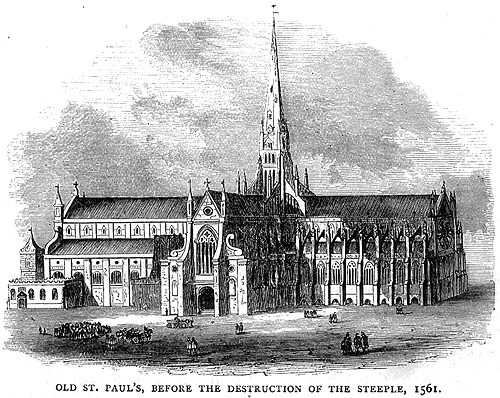 |

LD ST. PAUL'S in Elizabeth's reign lost its airy and graceful steeple by being struck by lightning, and many of the Roman Catholics at the time ascribed the accident to the anger of Heaven at the new doctrines preached there.
The beautiful steeple was never restored, but the roofs that had also been destroyed were replaced. The old church was partially restored by Inigo Jones, but the alterations intended were interrupted by the Rebellion, when art was suppressed entirely, and the hand of violence assisted in the destruction caused by the elements. The "body of old St. Paul's was converted," says Dugdale, "to a horse quarter for soldiers. The beautiful pillars of Inigo Jones's portico were shamefully hewed and defaced for the support of the timber work of shops for seamstresses and other trades, for which sordid uses that once stately colonnade was wholly taken up and defiled. Upon taking away the inner scaffolds which supported the arched vaults, in order to their intended repair, the whole roof of the south cross tumbled down, and the rest in several places of the church did after fall; so that the structure continued a woeful spectacle of ruin till the happy Restoration."
 It was as well, therefore, that the terrible Fire of London destroyed the whole cathedral, or at least reduced it to such a hopeless ruin, that Christopher Wren, our great architect, fortunately found it impossible to repair it. For he was thus enabled to build the present St. Paul's, which has long been declared to be second only to St. Peter's at Rome as a Christian church.
Wren was a man of great and varied talents; he was not educated for an architect; and before he exhibited his natural genius for the art, he had acquired a great reputation as an astronomer and mathematician. But he studied sedulously the art he loved, and was employed by Charles to assist Sir John Denham in the great works the King designed to have executed. Charles proposed, after the Fire, that Wren should design a plan for the rebuilding of the city; but the work was delayed, and the owners of the former property meantime rebuilt their destroyed homes according to their own sweet will.
It was not until 1675, nine years after the Fire, that Wren was able to lay the foundation of the great Cathedral.
Sir Christopher's first design differed greatly from the last he adopted; it has been said that the Duke of York, hoping that some day the church might pass back to the Roman community, interfered in the alteration; but if he did so, the change was certainly for the better, as the design is grander. The above plan was the one finally adopted.
The cupola is by far the most magnificent feature in the building, and nothing can be more pure in style than the peristyle with its unbroken entablature.
There is an anecdote recorded of the motto, "Resurgam," on the south front. It is said that while Sir Christopher was meditating about the motto he should select for his building, he required something to raise a stone about to be placed in position, and a workman brought him for the purpose a piece of an old tombstone on which was graven the word "Resurgam." The great architect at once saw the aptness of the word for his rebuilt church, and adopted it for his motto, perceiving that it was not only suitable for the church, but that it contained also a blessed promise to those who slept beneath the cathedral roof.
There are some fine monuments in St. Paul's; the one with the figure of Nelson with the lion beneath him, that of Sir John Moore wounded and dying, Sir Ralph Abercrombie falling from his horse into the arms of a Highlander, are admirable, and there are fine ones also erected to the memory of Howe, St. Vincent, Heathfield, Collingwood and Duncan; Dr. Johnson and Sir Joshua Reynolds. Nelson did not lie, as he had hoped, in Westminster Abbey, but is buried in the centre of the cathedral, beneath the dome, where he lies by his great contemporary, Wellington - the greatest sailor and the greatest soldier of Britain side by side.
The interior of St. Paul's is impressive and grand, but might have been brightened by greater ornamentation, as of stone carving and statuary. Wren left niches for the latter, which have never been filled.
Wren's scientific knowledge is manifested in the Whispering Gallery, which is a singular product of acoustic art. The geometrical staircase and the big bell are worth noticing. The clock is wound up by a donkey, the great key being very difficult to turn; the writer, when young, had a crushed foot from having been so silly as to take the donkey's place and attempt to wind it up!
The view from the cupola of St. Paul's is absolutely wonderful. The great capital lies so far below that all the noise of the streets is hushed, and no sound rises from its thronging millions. Every object beneath looks reduced to the size of Lilliput, yet we can distinguish the Post Office, St. Martin's Church - another production of Wren's genius - and St. Bartholomew's Hospital; while the tiny green trees interspersed amongst the buildings make the town very picturesque from this bird's-eye view of it. The Mansion House, the Mint, the Tower, and the Monument can also be seen here.
Wren found his own resting-place in the cathedral he had built, and needs no monument but his magnificent work to preserve his name as long as his country exists.
|
 |